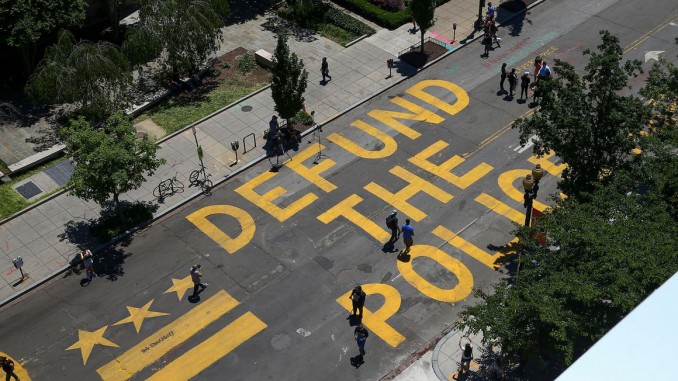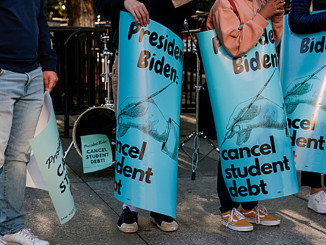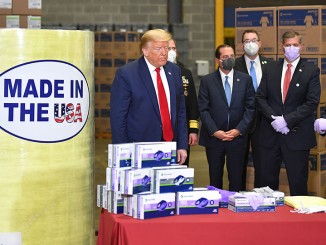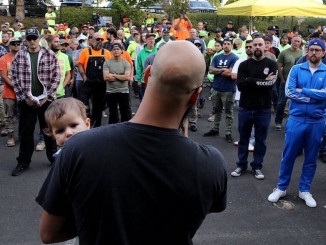
Introduction
The recent killing of George Floyd at the hands of the police has sparked outrage. Millions of people have hit the streets to demand an end to police violence, systemic racism, and Black oppression. With daily demonstrations and rallies being held in cities and towns throughout the country and around the world, people are refusing to stay silent.
These eruptions come at a time when police brutality continues to terrorize communities. The U.S. leads all countries in police killings with an average of 1,000 people killed by cops each year. This is in comparison to other wealthy countries like England and Wales who have had 55 fatal police shootings in the past 24 years. In violation of international guidelines, police in the U.S. are also more likely to use deadly force over non-violent or less lethal options. Police recruits spend seven times as many hours in firearms training than they do in de-escalation training.
The number of police killings disproportionately affects Black people. Despite only making up 13% of the U.S. population, Blacks are three times more likely to be killed by police. One out of every 1,000 Black men in the U.S. will die at the hands of law enforcement. Black drivers are also 20% more likely to be pulled over than white drivers.
The racism that drives police bias and brutality is clear. And it’s not slowing down. Since Floyd’s death, with hundreds of thousands of people in the streets demanding an end to police terror, police murders have continued. The murder of Rayshard Brooks by Atlanta police, who was shot in the back as he ran away was captured on video and viewed by millions. In Vallejo, California Sean Monterrosa, was shot five times as he knelt with his hands up. His murder was witnessed, but not videoed.
Defund the Police: A Popular Slogan
In the wake of this global upsurge, nationwide calls have grown to “defund the police” as a way to confront police racism and violence. It’s a proposal that’s been pushed by activists for some time in response to the continuing failure of police reforms. Recently it’s been gaining increased support and media attention and it has resonated with many people who are beginning to focus their energies on reforming the police.
Most advocates are calling for the huge resources and budgets that are normally allocated for police departments to be used instead for social services such as education, healthcare, and housing. Doing so, they say, will better address the root causes of what is viewed as “crime” like poverty, mental illness, and homelessness. Others are more focused on addressing police practices and policies like what incidents the police should respond to and whether they should be armed or not. For others “defunding” is not enough and they are demanding the complete abolition of the police. Instead of a police force, they are in favor of developing community response networks to resolve disputes using non-violent methods.
The meaning of the slogan “defund the police” may continue to evolve and be shaped by those fighting for it.
The Response from Government
As the demand to defund the police continues to grow, government officials at all levels have been forced to respond. In Minneapolis, the epicenter of the George Floyd protests, the City Council recently pledged to “dismantle” their police department. They say this will start a year-long process to engage with the community and study how a new public safety system could be implemented. This includes a ballot measure in the November elections where people will vote on reducing the number of city police officers. In New York City and Los Angeles, the Mayors have proposed minor cuts to their multibillion dollar police budgets that they say will be reinvested in social programs. At the state level, New York governor, Cuomo, quickly pushed through a series of reforms directing all cities and towns to redesign their police forces by April 2021 to continue to be eligible to receive state funding. This mandates banning chokeholds, making officers’ disciplinary records available for public review, and reviewing current policing practices.
At the federal level, politicians have also been pressured to do something. Although initially silent, top Democrats have responded to the crisis, but in their usual ways—by introducing legislation to better train police officers, proposing new commissions to address racial disparities, and, of course, by asking people to vote for them in the upcoming elections to get any of this done.
Democratic Presidential Candidate Joe Biden has made it clear he doesn’t support defunding the police at all, and actually wants to give police departments an additional $300 million to implement what he calls “meaningful reforms” such as retraining of police officers.
Other officials have dismissed the proposal as being impractical, irresponsible, and even dangerous, while some have simply stayed clear of the demand to defund the police all together.
Trump has made the question of the police a key aspect of his re-election campaign, branding himself as the “Law and Order” president and portraying the Democrats as being weak on crime and not supportive of the police. His recent executive order proposes guidelines and training measures that would be paid for by the Federal government, if approved by Congress. He had to address the strangulation of George Floyd, saying “chokeholds will be banned except if an officer’s life is at risk.” The insignificant impact of Trump’s proposal to control police violence was reflected by the praise it received from the National Fraternal Order of Police (FOP), the largest police union in the U.S., which defends cops no matter how horrid their crimes.
Reforms Will Not Be Enough
The solutions being offered by politicians are not new. Similar reforms were introduced in 2014 following a wave of protests that ignited over the police killings of Mike Brown and Eric Garner. The Obama administration created the President’s Task Force On 21st Century Policing to supposedly address police brutality. But the task force did nothing more than develop reports and provide advice on what to do. Most police departments ignored their recommendations. The use of police body cameras and review commissions were also adopted. But these changes have done little to prevent police murders and hold officers accountable for their actions. In fact, many of the videos that have led to a response have come from witnesses using their cell phone cameras.
Since 1994, the federal government has also had the power to subject local police departments to federal supervision, what’s known as a “consent decree”. The decree claims to monitor and reform police departments that are engaging in unconstitutional, unlawful, and racist behavior and policing. Many police departments have come under this order with some remaining under it for years without seeing much improvement—the city of Oakland’s police department has been under federal oversight since 2003! And under the Trump administration, the practice of using consent decrees has been largely rolled back anyway.
Implementing stricter policies and procedures doesn’t necessarily mean police will follow them. Cops have some of the most powerful unions and are often protected from lawsuits under the “qualified immunity” doctrine, which basically protects cops from civil lawsuits for most actions they have carried out because they are “just doing their job.” So, they have no problem using lethal or brutal force knowing that they will get away with it. Basically they have a license to kill. As a consequence, only 104 police officers have been charged with murder or manslaughter, since 2005. As of 2019, only four of them have been convicted of murder!
It should be clear that attempting to reform the police once again will not lead to any significant changes.
Protect and Serve Who?
The police do not exist to protect and serve the majority of us. Since its formation, the main role of the police has been to defend the ruling class and the property they own and control.
The first police forces were formed in the early 1700’s, in the South, as slave patrols to capture runaway slaves and return them to those who claimed ownership. Beginning in the early 19th century, modern police departments began to form in the industrial North and were used to violently suppress striking workers and patrol working class neighborhoods. In 1916, the large-scale movement of Black people from the rural South to the cities of the North and West began, known as the “Great Migration.” From that point on, much of the focus of the police shifted from recent immigrants and white workers to the violent control of Black people in the urban areas. Fast forward to today and we see the police playing the same role.
Despite the sincere attempts to reform the police, police forces have been playing an increasingly repressive role. This is marked by an ever-increasing militarization of local police forces in recent decades. As part of a program established by the 1997 National Defense Authorization Act under President Clinton, local police agencies have received vast amount of surplus military equipment. Between 1997 and 2014, they have received $4.3 billion in military-grade gear including tens of thousands of machine guns and assault rifles, 600 mine-resistant-ambush-protected vehicles (MRAPs), 205 grenade launchers, and thousands of night-vision equipment and camouflage gear. Under the program, agencies that receive military equipment are required to make use of it within a year of acquiring it or they must send it back, essentially forcing them to use it against us.
All this equipment has been added to the already heavily armed Special Weapons and Tactics (SWAT) Teams that exists in most police departments. The Los Angeles police department began to develop one of the earliest SWAT teams following the Watts rebellion in 1965. It served as a model across the country. It’s first major deployment was against the Los Angeles Black Panther Party office. In the early morning of December 9, 1969, a force of 350 police took part in the assault which, after a four-hour gun battle, led to the surrender of the six Panthers who were in the office. Since that time, SWAT teams have been used for other political attacks. They have been overwhelming used against Black communities across the country – mainly for drug raids and to serve arrest warrants. Of the approximately 50,000 SWAT raids that take place each year, only 7% are for “emergency situations.”
The Violence of Poverty
We cannot talk about police violence without understanding the conditions that give rise to it. Police brutality maintains the social and economic inequalities of capitalist society. Minneapolis, for example, is one of the poorest cities in the country with a poverty rate of 20.7%, a 9.4% official unemployment rate, and an estimated 4,000 homeless people. Its racial disparities are some of the worst nationwide. The median yearly income for Black families is $38,178 compared to $84,459 for white families. The Black poverty rate is 25.4% which is over four times higher than that of white residents, and the incarceration rates for Blacks is eleven times that of whites.
There are never going to be enough jobs for everyone under capitalism. The poverty and inequality that results pushes some people into “criminal activity” for survival. But the real crime is creating the desperate conditions that people live in. These poor and working class communities, especially those composed mostly of people of color, face cops who are given the authority to maintain control by any means they choose, including using violence and lethal force. People not only face the violence of the police, they also face the threat of going to prison for any infraction the cops want to make up.
We Need to Rethink Public Safety
Due to the high levels of crime and violence that exist in many communities, many people feel the need for some sort of security force to protect them from possible threats. And with no alternative they look to the police. But public safety shouldn’t just focus on protecting our lives. Feeling safe in society means having a secure job, a place to live, access to healthcare and education, as well as other basic necessities. This is not the case in the U.S. where an estimated 80% of working people are living paycheck to paycheck, over half a million people are homeless on any given night, and 28 million people don’t have health insurance. This is happening at a time when the three richest billionaires in the U.S. own more wealth than the poorest 50% of the population!
Where Do We Go From Here?
The growing push to defund the police is an understandable demand in beginning to address the issue of police brutality. Of course, with the reforms that are being held out, we will take what we can get at this time, especially the redirecting of police funds into poor communities. But we shouldn’t stop there.
We need to recognize the limits of the attempt to defund and reform the police. Whatever is offered will not lead to the elimination of the system of capitalism, the root cause of most of the issues that plague our society. We must go beyond attempting to eliminate the police forces. For us to truly be safe, we need to get rid of the system of capitalism which creates and maintains the inequality we face. It makes no difference whether the governments are headed by Democrats or Republicans, they both defend the interests of corporations and the 1%. The police play a defined role in this society. The police are there to serve and protect the 1%. Capitalism and its police go hand-in-hand.
The goal of the reforms the politicians are proposing is to get us to stop protesting in the streets and instead go home to watch and wait. Governor Cuomo said it very clearly after he pushed through the proposals to reform the police in New York.
He said, “You won, you won. You accomplished your goal. Society says, you’re right, the police needs systemic reform. That was accomplishment one. Now, go to step two.” (Step two is to wait for the process of police reforms to take place, city by city and town by town, if ever.)
They can pass their laws and talk all they want, but the reality of police terror remains. The reality of racism remains. The reality of poverty remains. The reality of our exploitation remains and will remain as long as this system stands. The politicians know about the racism of this society. They have chosen to ignore the terror it brings into many people’s lives. And they have refused to take even minimal steps to do anything about it.
The times have changed, and the politicians have been forced to act because of the determination that hundreds of thousands of us have shown in the streets, for the last month. If we continue to organize and depend on our own forces this mobilization can be the beginning of a fight to really change this society. We have the power to end this system that rests on exploitation, oppression and racist violence.
The question in front of us is whether we look to others for reforms or whether we stay mobilized and look to ourselves?




